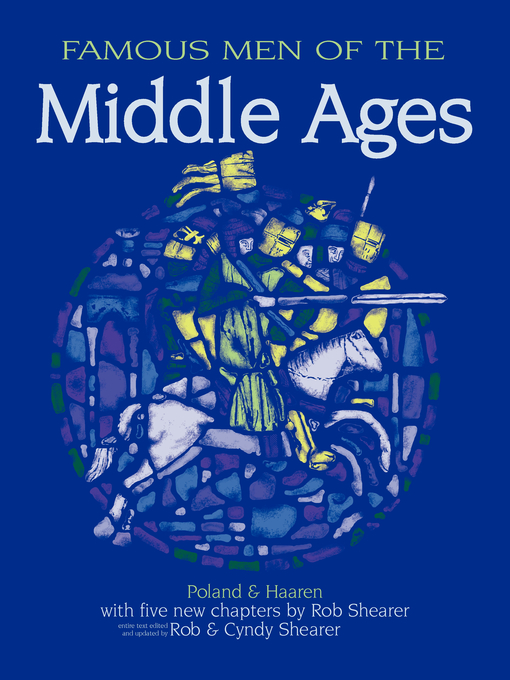 When we were reviewing the text of Famous Men of the Middle Ages in 1992, just prior to re-publishing it, I was aware that, although it was great book for children, its list of Famous Men omitted some important people. That’s not too surprising for a text originally written and published over 100 years ago.
When we were reviewing the text of Famous Men of the Middle Ages in 1992, just prior to re-publishing it, I was aware that, although it was great book for children, its list of Famous Men omitted some important people. That’s not too surprising for a text originally written and published over 100 years ago.
There had been a flurry of interest in teaching history to children around 1900. The Superintendent of Schools from New York City (John H. Haaren) and the Superintendent of Schools from Newark, New Jersey (A.B. Poland) collaborated on four biographical readers for children. They were both classically educated and did a very good job of selecting the subjects for their readers.
But they left out some important figures from church history. When we published Famous Men of the Middle Ages in 1992, I decided to add three chapters to add important material that would help students understand some of the important developments in the history of the church.
The first chapter I added was on Benedict (480-547) and Gregory (540-604). Benedict, of course is the founder of the Benedictine order and the author of the Rule of St. Benedict. The Benedictine order is the most important of the monastic orders and their communities were crucial for the course of medieval history and the preservation and development of medieval culture. Gregory was a Roman aristocrat who became a Benedictine monk and was later elected Bishop of Rome, or Pope. His re-organization of the church led to his later reputation as Pope Gregory the Great. Among other things, he commissioned missionaries to carry the gospel to the Angles and Saxons in Britain, and he gave us the form of church music known as “Gregorian chant.”
The second chapter I added was on Pope Gregory VII (1020-1085) and Emperor Henry IV (1050-1106). Pope Gregory VII (also known as Hildebrandt) had been a Benedictine monk and part of the monastic reform movement led by the Benedictine monastery at Cluny. When he was elected Pope, he challenged the practice of the Emperor to control the church in his territory and to appoint bishops. The struggle to clarify the relationshiop between church and state is an old one. In order to understand later developments, you need to know the story of these two antagonists and the controversy known as the “Investiture Controversy.”
The third chapter I added was on Francis (1182-1226) and Dominic (1170-1221), the founders of the Franciscan and Dominican monastic orders. In many ways, the movements led by these two prompted a widespread revival and partial reform of the church. The popularity of the two orders, and the rising prosperity of Europe coincided to create a building boom that led to new monasteries and churches by both orders throughout Italy and the reviving cities of the north.
I believed that the additions of these three chapters made the Famous Men of the Middle Ages a better book. Obviously others did, too. Since the original text of Famous Men of the Middle Ages is in the public domain, other companies are free to reprint it. At least one company that has done so added the same three chapters as we did in 1992 with exactly the same chapter titles and substantially the same content.
For some time, I have felt that some further updating to the Middle Ages book would be a good idea. As I wrote the Famous Men of the Renaissance and Reformation, I continued reading widely in medieval and reformation church history. Although the text of Famous Men of the Middle Ages mentioned both Augustine of Hippo and Patrick of Ireland, I became increasingly convinced that they need their own chapters.
So, I am very pleased to announce that in the NEW edition of Famous Men of the Middle Ages, now available from Greenleaf Press, we are including two new chapters: Augustine of Hippo (354-430) and Patrick of Ireland (390-461). I circulated drafts of both chapters among my children and made some revisions they suggested. I’m proud of the results. I think they will give readers a much better picture of the early middle ages, and the course of church history.
I have also taken the opportunity to update a few chapters (notably standardizing the name of the Vandal King Gaiseric to conform to modern usage – in the original text, he is called Genseric, an older form of the name). I have also re-written the chapter at the end of the book on Warwick the Kingmaker which covered the War of the Roses in England. The original text attempted to simplify the historical account by omitting a number of important details. I have expanded the account and tried to show the relationships of the players a bit more clearly.
There are several editions of Famous Men of the Middle Ages now on the market. Only the edition by Greenleaf has the five added chapters authored by Rob Shearer on important figures from church history.
The book is available as a paperback ($16.95) and as an eBook ($12.00) from Greenleaf Press. Or you can buy both the paperpack AND eBook together for $22.95.
There is also a Greenleaf Guide to Famous Men of the Middle Ages, though it will be a little while before we can update it to include guides to the chapters on Augustine and Patrick. For everyone who purchases the Greenleaf Guide now, we will provide a .pdf of the new pages when they are ready later this year.
– Rob Shearer